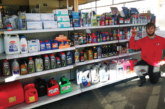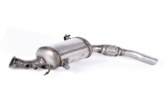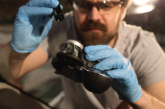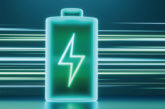
PMF hears from Quentin Le Hetet, General Manager at GiPA UK, and Tristan Kitchin, GiPA’s Research Manager, who look at how some of the industry’s big players’ attempts to consolidate market share could affect the IAM and whether independent motor factors still have a place in the industry.
The ‘independent’ aftermarket
With a total of 35.2 million passenger car workshop entries in 2016, the UK aftermarket has proven to be an appealing area for business. It currently has the fourth largest passenger car parc in Europe with 30.85m cars, and is quickly catching up with third place France on 30.9m cars.
But forget the figures; what makes the UK so attractive is its market make-up. Unlike its European neighbours, whose aftermarkets are home to large business chains, the UK is largely dominated by independently run businesses.
There has been a shift in recent years however. The independent aftermarket is still largely independently run, but a handful of larger players have sought to consolidate their market position, and at every level of the supply chain.
The consolidation movement: Motor factors
In an increasingly competitive market place, with tightening margins and an increasing number of players, efforts to consolidate market share have seen some businesses move from building partnerships into acquisitions, targeting local companies and regional and national groups across the UK. A few market leaders have been making waves at every level of the IAM
using this strategy, hoping to increase their market share in what is a largely fragmented market in order to reach a critical size of consolidated turnover.
2011 can be viewed as the start of this ‘consolidation movement’; it was then the American auto parts company LKQ, which had no European base of operations prior, bought out Euro Car Parts. LKQ, managed by the world’s largest investment firm BlackRock, entered the European market with a clear integration strategy; become a major European player via extensive market acquisitions. With its financial might, in following years LKQ would also purchase Andrew Page and make a
number of purchases across the continent, including the established Italian firm Rhiag, and Sator/Van Heck in Benelux.
Uni-Select, another North American player, bought out The Parts Alliance in June 2017. It echoes LKQ’s buyout of Euro Car Parts in 2011; are they planning on using The Parts Alliance as a gateway to the European market, much like LKQ have done with Euro Car Parts?
The Alliance Automotive Group (AAG) has made similar advances in recent years. Although its Groupauto network was already present in the UK prior to 2011, AAG developed a similar strategy. In 2015 AAG bought out the United Aftermarket Network (UAN) and, since the start of 2016, has purchased BTN Turbo, Apec Braking, FPS, and at least 17 other part distribution businesses, representing 47 branches. This only sums up AAG investment in the UK.
Buyouts have become commonplace in distribution channels. This movement has not just been limited to distributors however, but has had an impact on installers as well.
The consolidation movement: Garages
Currently, around 12% of all independent garages in the UK belong to a network, and this figure is on the increase; ServiceSure, The Part Alliance’s garage network, recently claimed garages have been joining its ranks at a rate of 15-a-month since the start of 2017; and AutoFirst, LKQ’s garage network, just passed 200 members, up from 90 at the start of 2017.
There are a number of well-establish networks in the UK, including Groupauto’s AutoCare and Bosch’s Bosch Car Service. But the repairer network space is about to get a lot more crowded. UAN recently announced their intention to build their own garage network, as have PSA, who hope to recruit 600 garages to its Euro Repair network.
Around half of these 12% are members of the network run by one of the ‘big three’ distributors however: The Parts Alliance (Uni-Select), Groupauto (AAG), and Euro Car Parts (LKQ).
These three have been recruiting repairers to their networks for years, and this has become as important to their market consolidation efforts as the acquisitions at the distribution level they have been making. The larger the garage network, the larger, and more consistent, parts sales for their distributors.

Catching up with Europe?
Although this movement may be new to the UK aftermarket, it is not limited to it; AAG and LKQ have been making acquisitions across the continent too. Both have bought several businesses, extending their distribution empires across Western and Eastern Europe.
But this isn’t anything new on the continent; Germany and France have been experiencing consolidation in the independent aftermarket for years. Germany is prime example; its IAM has been slowly merging together since the fall of the Berlin Wall. First at the installer level in the 90s, picking up speed at the wholesale level in the 00s, and then at the manufacturer and trade levels in the 10s.
Today, in Germany, around 50% of independent garages are a member of a network; in France, this figure is around 56%. Both are significantly higher than the 12% seen in the UK.
David vs Goliath?
The UK’s largely independent make-up is what makes it so enticing for businesses hoping to gain a foothold; hence the many large transactions that have been occurring since 2011. The UK IAM’s potential for growth and low barriers for entry has made the UK a prime target for newcomers who simply want to buy in.
But the UK is, to an extent, seeing the same thing that happened (and is still happening) in Germany and France.
Is this good, or bad, for the IAM though?

Some independents, not part of a network, have viewed the whole movement with worry; in most industries ‘Goliath’ multinationals seeking to take control via hostile means are rarely viewed positively.
GiPA’s research has shown quite a few distributors and traders view this movement optimistically however. Some believe the competition in the market will push prices down, therefore increasing profits. Some have noted that the business assistance offered by the networks has allowed them to focus on what they are good at; selling or installing parts. Others are simply looking forward to a retirement payday, when their network offers to purchase their business.
Some independents though – those wishing remain as such – have seen an opportunity to differentiate themselves; they offer a flexible service and improved customer proximity as opposed to the multinational processes and administration brought on by being part of a network.
Whatever way the consolidation movement plays out, what is apparent is that there are more options right now for independents than ever before. Right now, the consolidation movement is what independents make of it.







